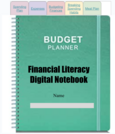
Students will analyze monthly household expenses, explain the benefits of using a budget, and create a sample budget.
- Subject:
- Financial Literacy
- Material Type:
- Lesson Plan
- Author:
- Utah Lesson Plans
- Date Added:
- 02/07/2024

Students will analyze monthly household expenses, explain the benefits of using a budget, and create a sample budget.

While completing a digital worksheet, students will describe the purpose of a budget, classify expenses as needs and wants, and explain the difference between gross pay and net pay.

This lesson Plan is for Financial Literacy and Budget Planning. The Standards were not listed in the Resource section so they are as follows:Standard 1Analyze the role of cultural, social, and emotional influences on financial behavior.Evaluate the role of emotions, attitudes and behavior in making financial decisions.Recognize that individuals are responsible for their own financial decisions and for subsequent positive and negative consequences.Standard 2Define a rational decision-making process and the steps of financial planning.Define opportunity cost (tradeoffs) and their role in decision making.Describe a rational decision - making process.Identify short- and long-term financial decisions and the impact they have on financial planning.Define the elements of a financial plan.Standard 1Identify and explain the process of budgeting based on calculated income.Develop a budget.Identify and prioritize fixed, fixed variable and variable budget categories.The Image for this Budget Planner was created by myself, Sharon Pinkerton.

Students will create a zero-budget from a projected salary for a career of their choice, practicing the PYF principle and learning realistic costs of living.

Students will learn about SMART financial goals and then complete a worksheet where they will set personal financial goals, both long and short term.
Learning the art of smart shopping.